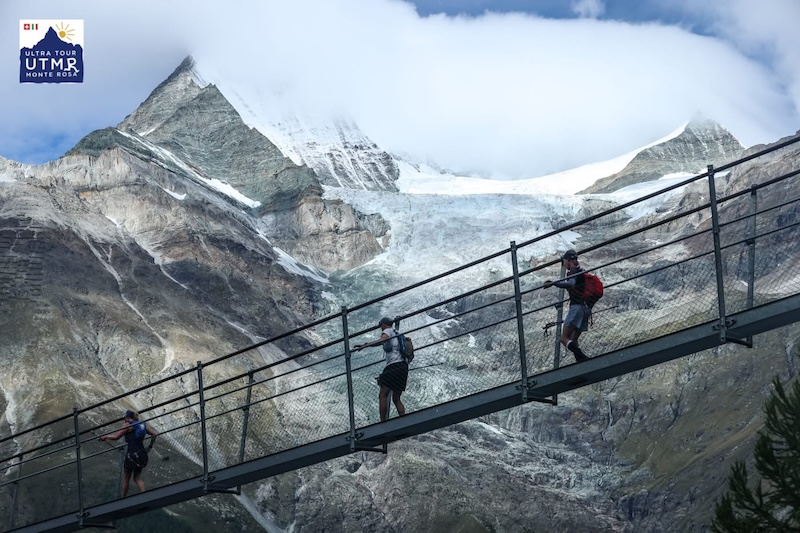There is a lot more to completing the four-day stage race, the Ultra Tour Monte Rosa, than “just” running. While running – and making sure you can run for many hours on trails and up and down mountains – is a vital ingredient when training for the event in the Swiss-Italian Alps, it’s really important to pay attention to the numerous other details to help you towards success.
I took part in this year’s race, along with a group of friends, Rachel, Cath, Selina and Natalie, and experienced a bit of a rollercoaster, both physically and mentally.
Overall, I greatly enjoyed the challenge of the ultra race that starts and finishes in Grächen, Switzerland, and takes in more than 11,000m of ascent and descent over a total distance of 170km. Each day, there was a cut-off of 12 hours, so the overall time available for the four-day event was 48 hours, with various other cut-offs at checkpoints during different days.
I have so far raised more than £2000 in memory of my mum who died three years ago. Please do donate if you can: GiveWheel.
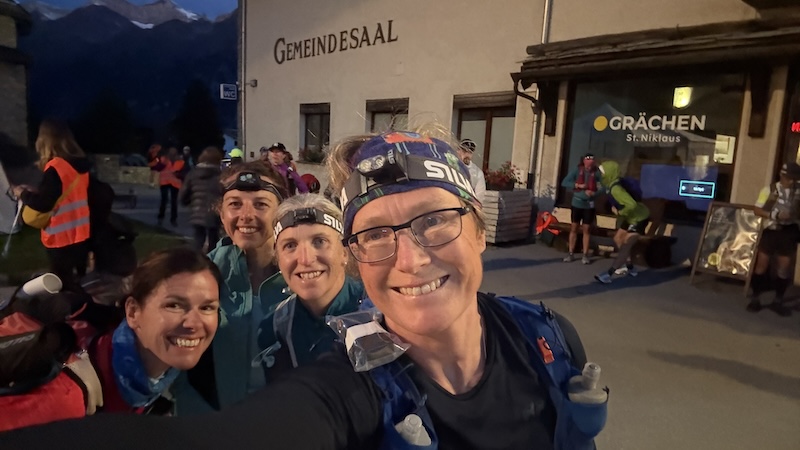
Here are some of the things I learned during the Ultra Tour Monte Rosa
1 Ignore the niggles
I was worried about several niggles, including sore knees, a tight back and potentially crampy calves and hamstrings in the two weeks prior to the race. I had convinced myself they would make the UTMR a much tougher outing.
In the end, I hardly felt these physical issues and by the end of the race, my body felt like it was in much better condition than when I started.
This shows that all the months of training and conditioning, helped by coach Nicky Spinks, and supported by friends, really paid off.
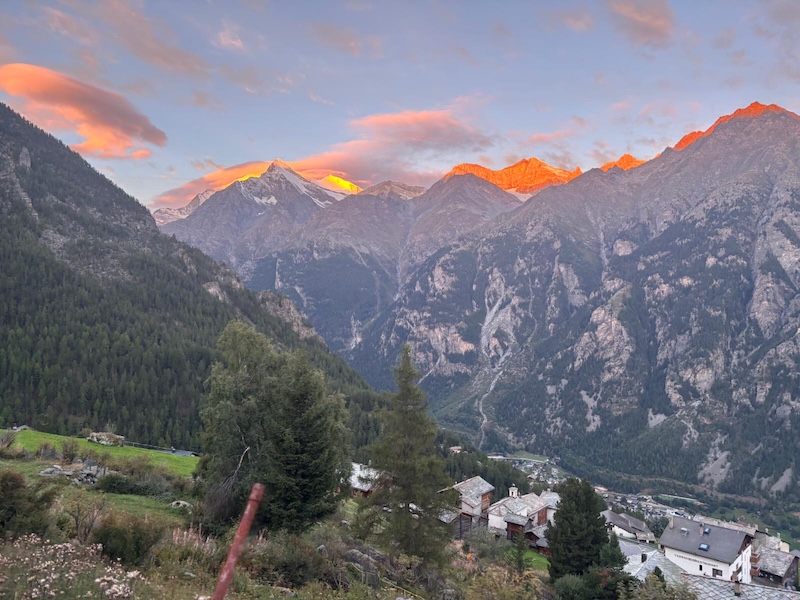
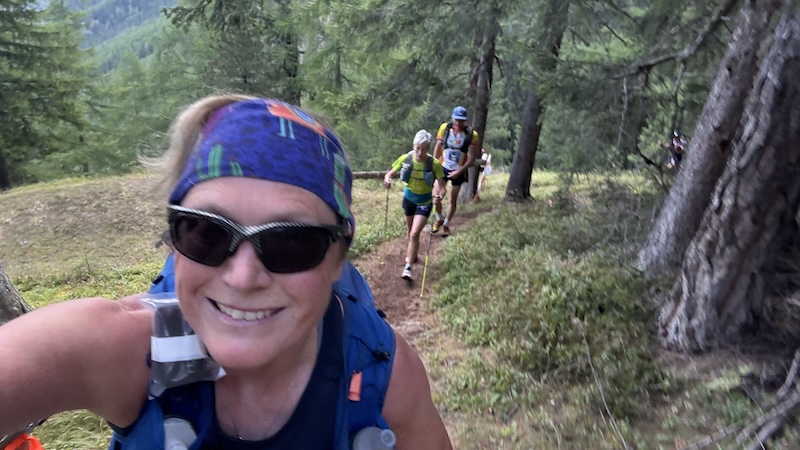
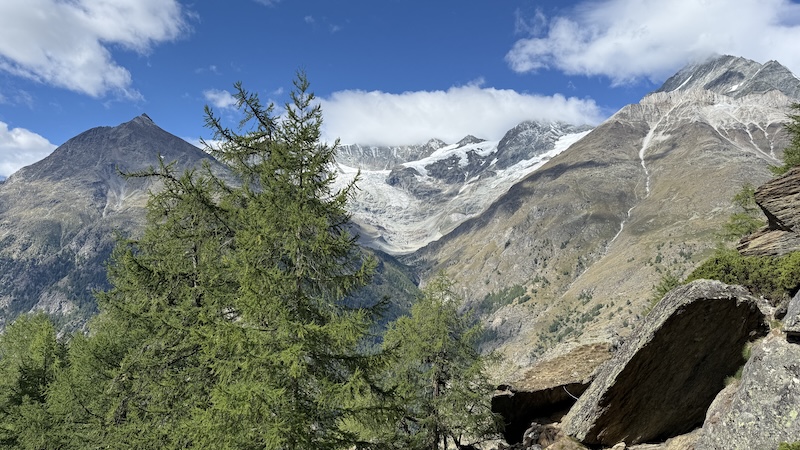
2 As I said, it’s not ‘just’ running
I overheard several runners talking about the race being a challenge of both running AND eating. Being fuelled enough to run long days – and day after day – is key to endurance events such as the UTMR.
For me, there is an added challenge of finding the right foods to maintain my energy but while avoiding stomach upset and digestive issues. I carried plenty of snacks and bars with me because I wasn’t always sure what the food stations would supply.
Some food stations had products I could stomach, others were less bountiful. And, at times, what was on offer wasn’t always what I fancied. For example, I leapt on a bowl of jelly sweets one day, while on day four, at the top of the first long climb, I was delighted to be offered a slice of a thin, crisply cooked omelette of cheese and ham.
I ate a mix of sweet and savoury and across snacks and light meals, such as soup and bread, and I always had my back up Voom Pocket Rocket bars.
There were times when I definitely did not fuel properly. On day one, I didn’t eat enough early on to keep me going with good energy towards the end of the distance of 34km with more than 2100m of ascent. I recall hitting a slump as we approached the final “flat section” and I could feel my mood change from happy to “hangry”. I learned from this and made sure I ate more earlier on the other days.
It’s important to note that in a race you tend to push yourself harder than in training and we were also covering a lot of distance, as well as climbing thousands of metres.
The aim was to eat the right amount – not too much that it gave me a sore stomach and not too little that I faded. Getting that perfectly right takes practice and I know it’s something I need to focus on more.
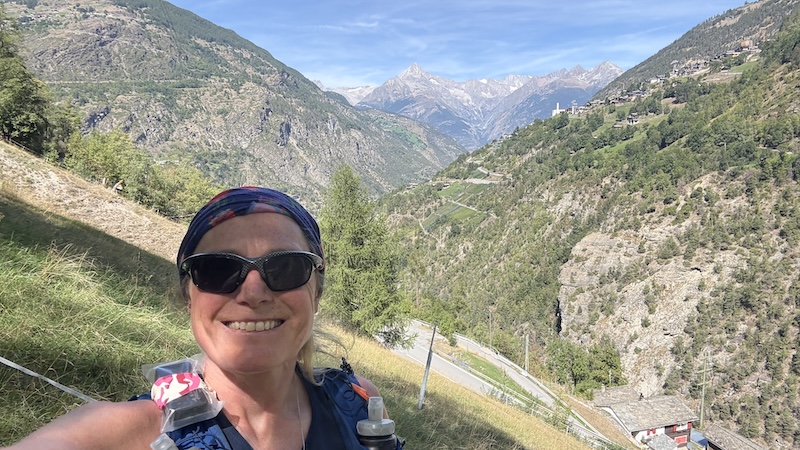
3 Hydration, hydration
Sipping water and other fluids frequently helped me to stay hydrated. Trying to “suddenly” rehydrate is not an option. I had two 500ml water flasks at all times, with one filled with water and the other a mix of water and Active Root sports drink or water and coca cola.
I was pleased with how I hydrated throughout the entire race and I never felt the ill effects of dehydration, although it did come close on the final day when it was hot and the final water/food station arrive later than I expected.
4 Cola has never tasted so good
I am not normally a fan of full sugar Coca Cola. However, during the UTMR, I glugged it down at every opportunity. I took swigs of neat cola at the food stations and I added a mix of half cola and half water to a soft water flask each day.
The cola gave me an energy boost when I needed it – and it tasted great.
Note: Adding fizzy cola to a flask with a drinking valve can be a little explosive! I was hit in the face a few times by a fast-escaping cola-water mix!
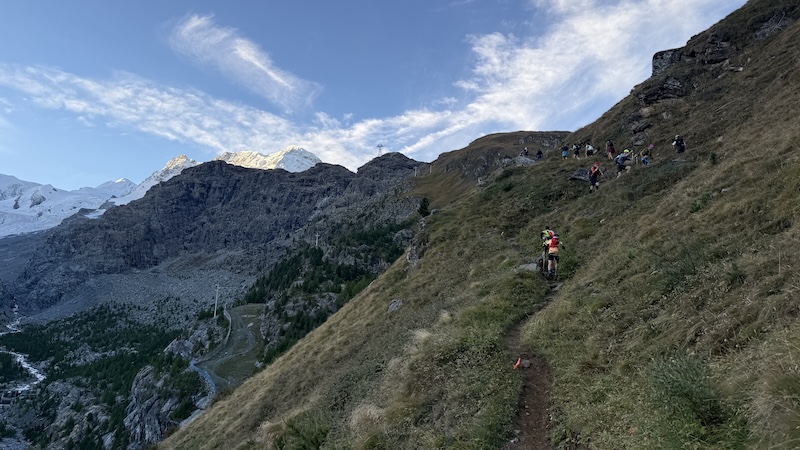
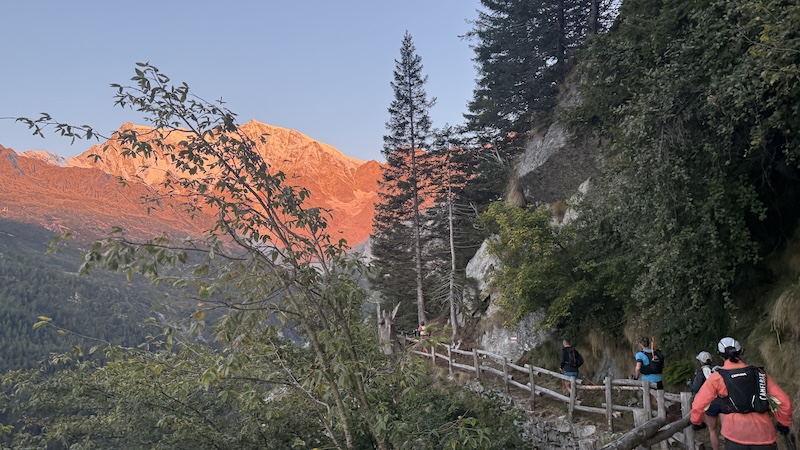
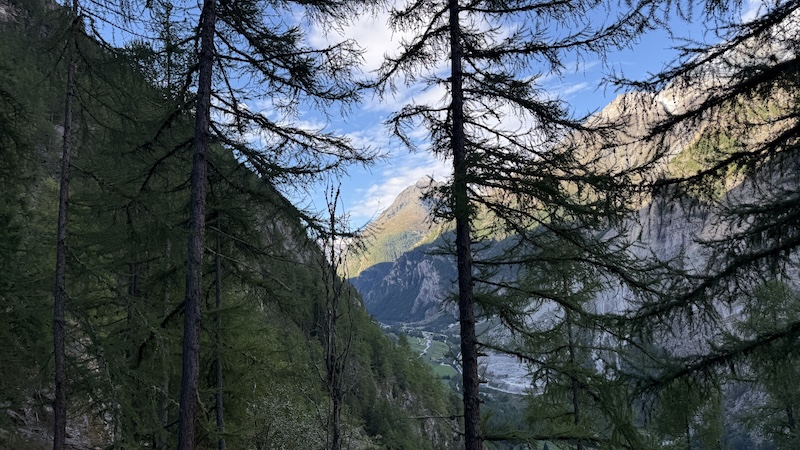
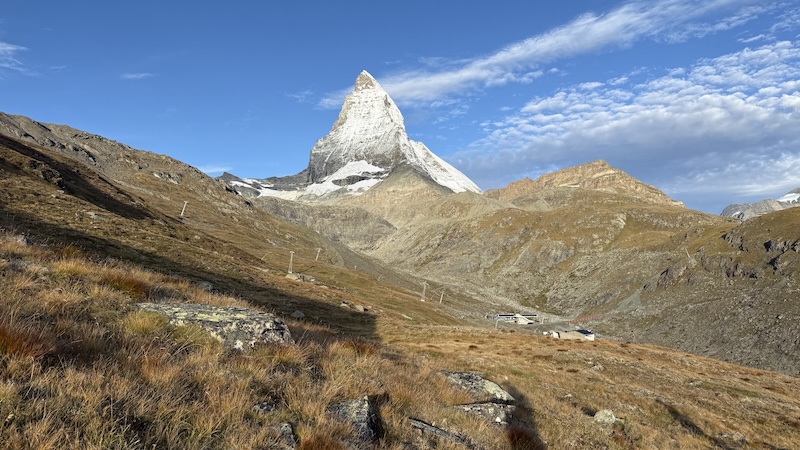
5 The views were incredible
The Monte Rosa is the second-highest mountain massif in the Alps and located on the border between Switzerland and Italy. The area is home to the Dufourspitze, the highest peak in Switzerland, and the second highest in the Alps. There are plenty more peaks over 4000m, too, as well as high passes, steep crags, ridges and lakes filled with milky blue glacial waters. The views are truly breathtaking.

6 Ups and downs – emotionally
There were many highs including spending time with friends, meeting like-minded people, visiting a fabulous part of Europe, the amazing views, a sense of purpose each day and crossing the finish line.
But there were lows as well. I was nervous of the unknowns and I had a dip in confidence before starting. I felt emotionally drained at the end of day one and for much of day two (see “altitude issues” below. Day three was tough as I grappled with upset and disappointment.
But overall, there were more highs than lows.
7 Ups and downs – physically
We started each day in a mountain town or village and climbed to many different high points between 2500m and 3300m. In some days we climbed several times and descended thousands of metres, too.
The UTMR is a physically challenging race and I was grateful for all the many thousands of metres of ascent and descent I’d done during eight months of training.
I chatted to many competitors who live in places such as The Netherlands, without easy access to mountains, and I wondered at how they fared physically in the UTMR.
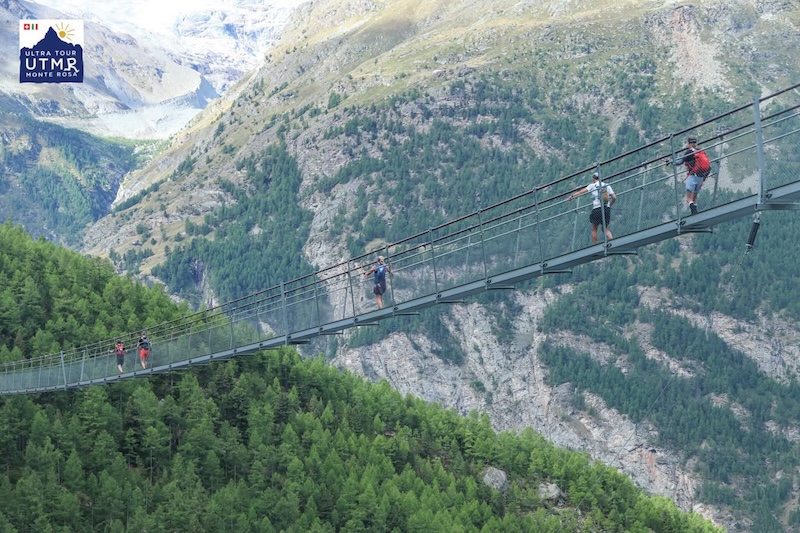
8 Altitude was not my friend
I have experienced the ill-effects of being at higher altitudes before, especially difficulty breathing while skiing in the Canadian Rockies. However, I didn’t expect to suffer during the UTMR.
Sadly, on day two, as we reached an elevation of between 3000m and 3300m – Theodulpass was at 3295m – I developed a very sore and thumping headache. I wondered at the time if it was effects of dehydration but I was well hydrated and it was quite early in the day.
I had pushed fairly hard up the first incline from Zermatt but I’d felt within my comfort zone and I wasn’t aware I was overly exerting myself.
The headache was vey painful – like a sledge hammer to my head – and I felt nauseous, a bit dizzy and suddenly very drained both physically and emotionally. I did mention this to a volunteer at a checkpoint and she said she could find me a nurse but I decided the headache would probably go and all would be well.
Sadly, the headache stayed and became more painful until I dropped a lot of elevation. I slowed my pace, tried to eat (I couldn’t swallow anything due to nausea) and kept drinking water.
I also started to cry and sometimes sob to myself. This is not something I normally do. It prompted me to call Hubby G (who was at home fitting our kitchen!), and he implored me to try to eat. I did try, but I simply couldn’t get any meaningful food down. I took two paracetamol as well.
I pushed on slowly and kept drinking as much water as I could. At one point, a fellow runner kindly asked me if I was okay and gave me three jelly-caffeine sweets, which I did manage to swallow but that was pretty much all I could consume for many hours afterwards.
When the headache finally started to shift and the nausea began to lift a little, I could eat a few morsels of snack bars.
This got me to a final food station at 30km where I sat for a long time trying to force down soup and bread and feeling somewhat dazed and strangely weepy. The volunteers were lovely and friends, Cath, Selina and Ian, gave words of comfort but even as I left the CP for the final push uphill and then to the day’s finish line I knew I was severely lacking in food and energy.
At this point I was still unsure what was wrong but Ian suggested it could be altitude issues as he had suffered similar.
I did make it to the finish point of day two – 43km and some 3000m of ascent – but I still felt nauseous and emotional.
I wish I could say that it passed quickly but the inability to stomach food continued that evening and despite an apparently delicious meal in the hotel, I could not even stand the smell of food, let alone eat much of it.
All I could do was retreat to bed and hope I’d feel better in the morning. I felt a little perkier the next day and I managed to force down a bit of breakfast but as I set off for what would be a very long day of running in the mountains, I knew I wasn’t well enough or properly fuelled. My food was coming back up and I still felt very weepy.
I took the upsetting but, I think, wise decision to report to the marshals that I wasn’t feeling too good. After many shed tears – my outpouring felt both physical and emotional – I reconciled my thoughts and decided to make the best of the day by resting, refuelling when I felt able and chatting to other competitors who had also been forced to take a day off, mainly due to physical injury.
I did wrangle with my thoughts and wondered if I could have done anything differently, Perhaps, in hindsight, I set off too fast. Maybe I didn’t fuel myself enough. But I did the same as on the other days and, as it turned out, on day four I was able to run a strong 50k based on similar actions as the start of day two.
A Facebook friend also suggested that I may have been suffering with low iron levels, which can apparently hinder the body’s ability to acclimatise. Another friend, a neurologist, wonders if it was a migraine. (I do get menopause related migraines but not normally painful, rather just ocular.)
In the end and after speaking to other runners who also reported the felt the ill-effects of the altitude, I think it was simply bad luck and, on that day, I had a bad reaction to the elevation.
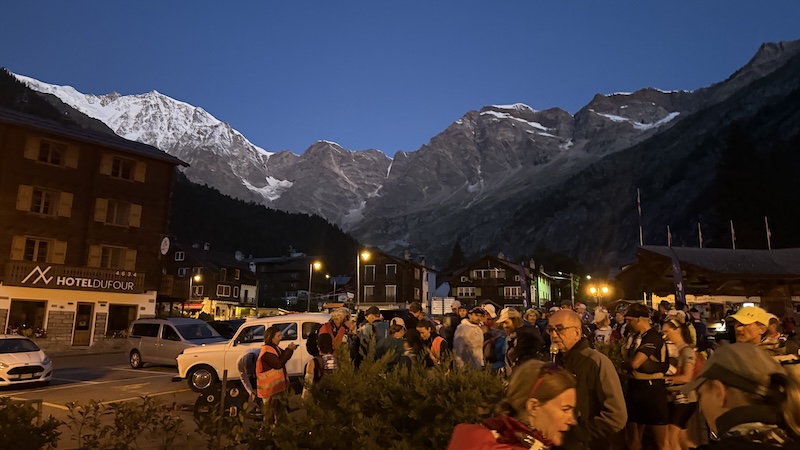
9 Hotels are far better than stage races with camping
One major attraction of the UTMR is nights in hotels. Each day, you finish in a town or village – Zermatt, Gressoney and Macugnaga – and then sleep in comfortable rooms, with the added bonus of showers and meals provided.
I shared a room each night with Rachel and on one night we had an extra room mate, Catherine from Switzerland.
Other stage races, such as the Cape Wrath Ultra, require nights under canvas in shared tents. In my opinion – confirmed during the UTMR – it is tough enough doing a stage race WITH the comfort of hotels, hot showers and meals indoors without adding the extra challenges of spending every night outdoors, potentially wet and cold and with camp food on offer.
I shuddered at the thought of the potential for also dealing with the midges of Scotland, too.
Cath and Selina became friends during the Cape Wrath Ultra several years ago and I have immense respect for them for dealing with the harsh reality of long running days in tough terrain and overnight camps.
10 Even in hotels, sleep was hard to come by
It was strange that after long days in the mountains, I found it almost impossible to switch off and sleep at night. I asked my friends – and they confirmed they were experiencing the same. We were all physically fatigued but we felt as if we had only short periods of sleep each night.
Perhaps that is the effect of worries about the race or being in the mountains at elevation. Another theory suggested is that the body is trying hard to recover overnight and somehow that affects sleep.
It was hugely frustrating to lie for hours not sleeping, although it was also very surprising how well we all managed during the days on so little sleep.
I remember my mum saying to me when I complained of lack of sleep before a judo contest as a child: “Even if you don’t sleep, you are resting your body.”
11 Pack ear plugs
Sleeping in a room with friends or strangers is usually a lot easier with ear plugs because you don’t need to listen to the sounds of heavy breathing, snoring etc.
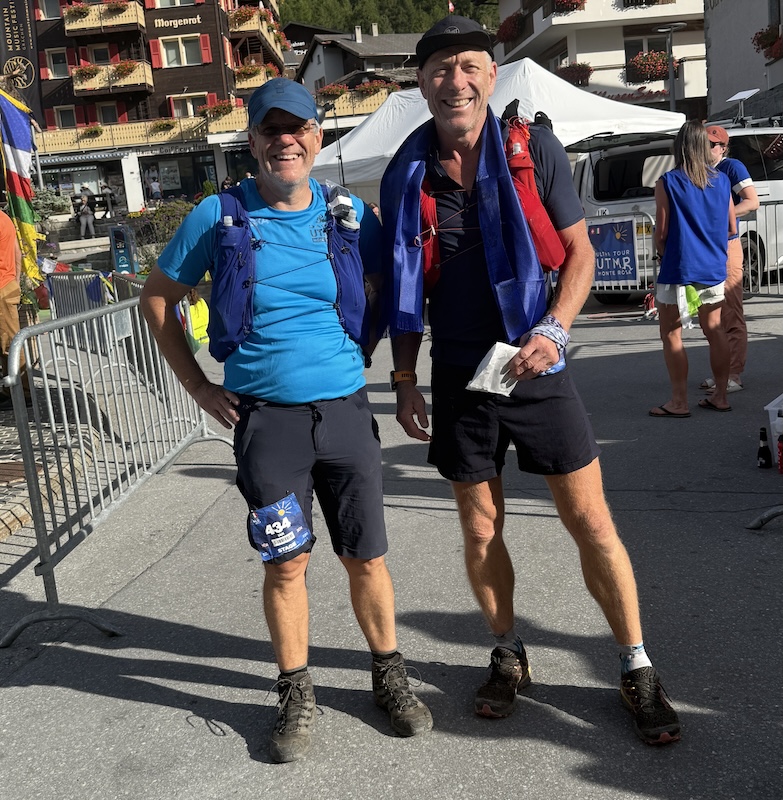
12 Pacing is paramount
Pacing to suit your fitness level, experience and training is paramount. It’s well worth practising this during the months leading up to the UTMR. Even though it might be difficult to replicate the terrain, elevation gain and descent, knowing your personal pace and how it will help you to complete the days of running is very important.
By day four, I think I had nailed this. A combination of brisk hiking uphill, running the flats and downs where I felt I could, eating and drinking at regular intervals and keeping my brain upbeat and happy allowed me to push quite hard but still feel strong even in the final few kilometres.
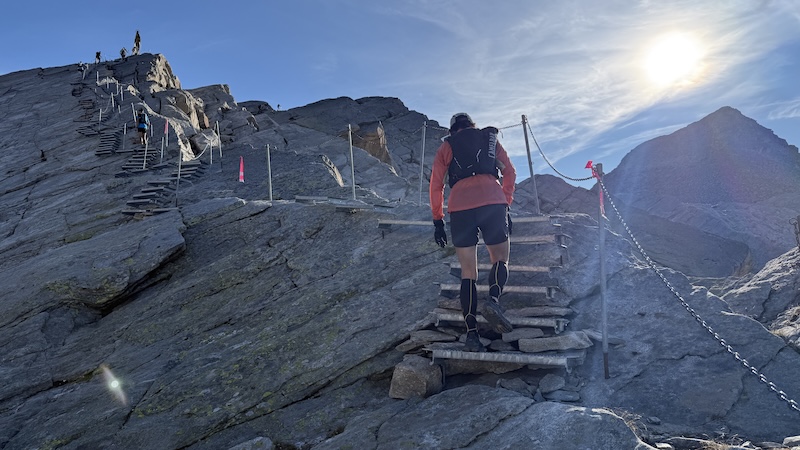
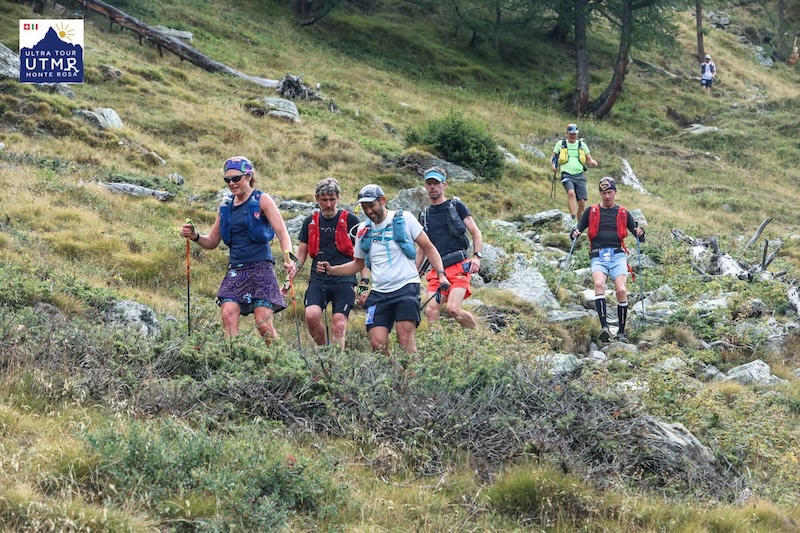
13 Nail the brisk walking
My friends Cath and Selina are pro brisk walkers. Cath, in particular, has a great form of brisk walking with the aid of her hiking poles. I can’t keep up with her pace of walking and normally need to break into a run alongside her.
Fast hiking can be very useful for maintaining pace, while not draining energy reserves.
14 The Alps boasts excellent trails
If you know Scotland, you’ll be aware of how tough our terrain can be. There are some paths in the mountains but there is also a lot of rough and rugged moorland. This is where I spent most of my time training.
It was therefore a total blessing to discover the wonderful network of trails in the Alps. Even when we were off-path and hiking and climbing over big boulder fields, it felt a great deal easier than the Scottish landscape.
This is not to say the the UTMR is on easy-going trails and paths. There is still a lot of ascending and descending on steep paths and rocky trails but I found it far less technical than most of Scotland’s mountains.
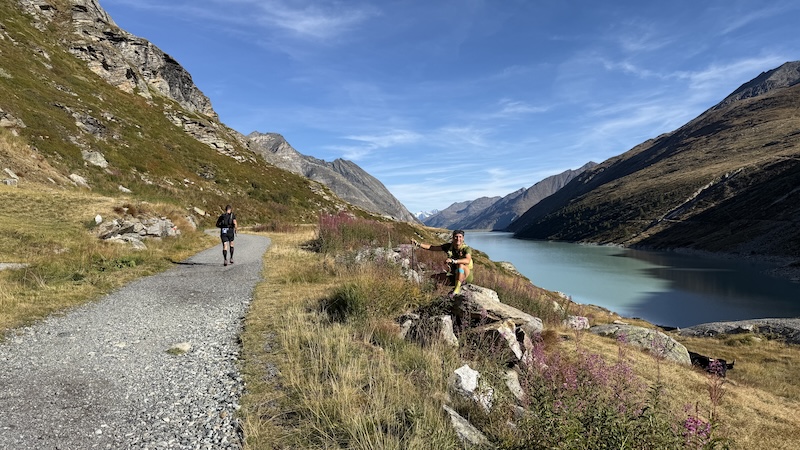
15 The UTMR signposting is superb
I did hear of one runner getting a bit lost one day but I found the signposting – with hundreds of small pink flags – absolutely amazing. It was very easy to follow the markers and while I did have a GPX route back-up on my phone and watch, I never needed to refer to these gadgets.
I spent large sections of the race on my own and I never worried about finding the route.
16 Strength, as well as fitness
I don’t think I could have completed the there days of the UTMR if I had focused only on running training. I do at least one session a week of “heavy weights”. I think this helped me to maintain strength and muscle and also my joints for the endurance event.
17 Take care of your feet
I am not prone to blisters on the skin of my feet thankfully, although I did suffer a painful blood blister under my big toe nail during the UTMR.
Other people are not so fortunate and they spent time each morning taping their feet and adding anti-chafing creams. Cath also swears by socks with individual toes.
One tip I have is to wear running shoes that are a bit long and wide for you. This allows feet room to swell in the heat and after many kilometres of running. It also prevents too much damage when running downhill for hours.
I used inov8 Trail Talons.
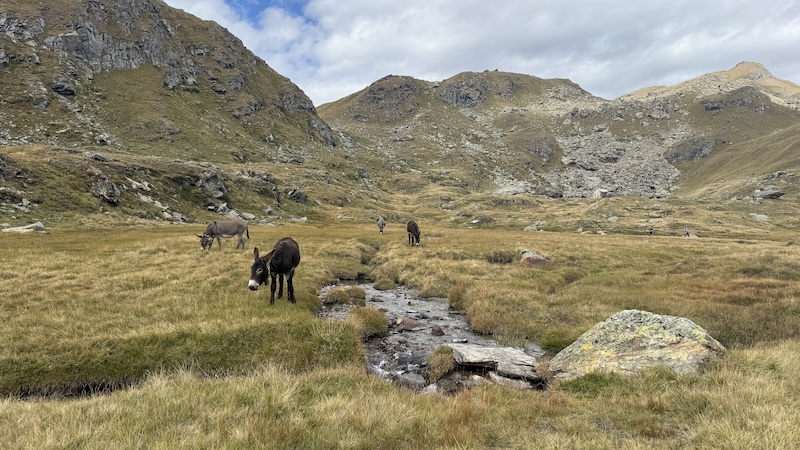
18 Essential kit is essential
The race organisers send you a long list of kit requirements. All these are a must and there is a pre-race check to make sure you have everything required.
On some days you can carry “only” the essential kit, while on others we needed to add poor weather items. There was a forecast of snow and rain at higher altitude so we needed to carry warmer layers.
I was able to fit all my kit into my Salomon Adv Skin 12 Running Vest. It was quite stuffed full at times but it still felt vey comfortable to wear. An update I’d like to see on this pack is a couple of stretchy pockets on the rear of the pack for stuffing items that I want to keep handy.
19 Hot, cold, hot
It was surprisingly warm in the Swiss and Italian mountains for September. Equally, at times, it was surprisingly cold. At higher altitude there was often a very cold wind and we ascended snow on a glacier.
I tried to stick to my motto of “be bothered”, which means that I stop to sort my kit and layers when I feel too warm or too cold.
In a race situation, even if you are not particularly competing, you feel the pressure of time. Certainly, we all needed to reach the checkpoints – some with cut off times – to be able to complete each day. But if I get too cold or too hot I can end up uncomfortable and miserable.
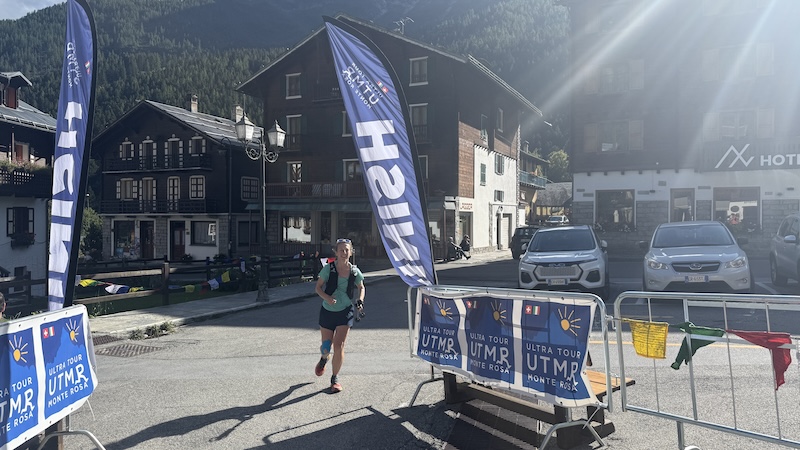

20 The sun can be more burny
High factor sun cream is a must. The sun can be more dangerous at higher altitudes because the atmosphere is thinner and filters out less ultraviolet (UV) radiation. Wearing high factor sun lotion and lip salve is vital to avoid burnt skin.
I made the mistake of using lip salve with only SPF15 (I thought it was SPF30) and I ended up with burnt and sore lips.
I also wore sunglasses to avoid the glare of bright sunshine.
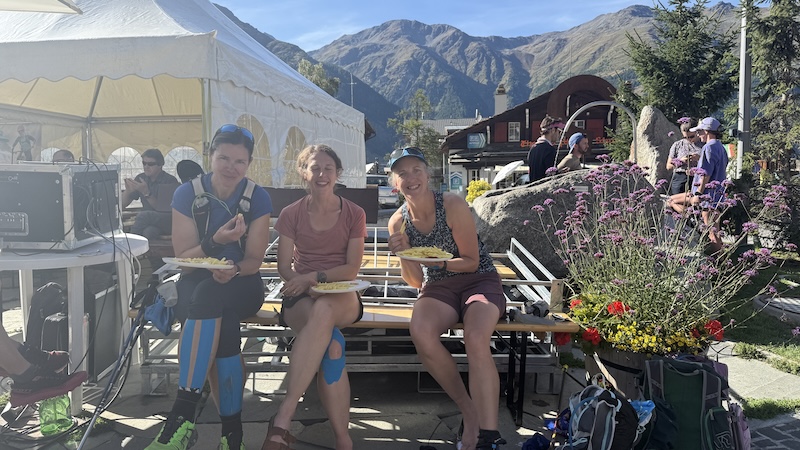
21 Pay attention to daily recovery
Long days in the mountains obviously put stresses on the body, including muscles, joints and energy. Eating well can make a big the difference to how you feel the next day. The first thing I did at each finish line was to find an ice cream. I want to thank Ian – who is a friend of Nat’s – for being an excellent finder of ice creams. He generously bought me two huge ice creams.
I never feel like eating much immediately after a long day of running but an ice-cream hits the spot. After that, refuelling and rehydrating felt easier to manage.
I also had a daily protein drink with added creatine powder. They don’t taste great but forcing these down is helpful for speeding up muscle repair and glycogen replacement, which can help the body to recover faster.
I used CompresSport Full Leg Recovery 2.0 leggings. These are like long sleeves for the legs and I am convinced they helped with muscle recovery overnight.
In addition, I took a massage roller with me and rollered my leg muscles every evening.
All of this did seem to help with how my legs felt the next day. I was amazed by how good my legs felt throughout the event.
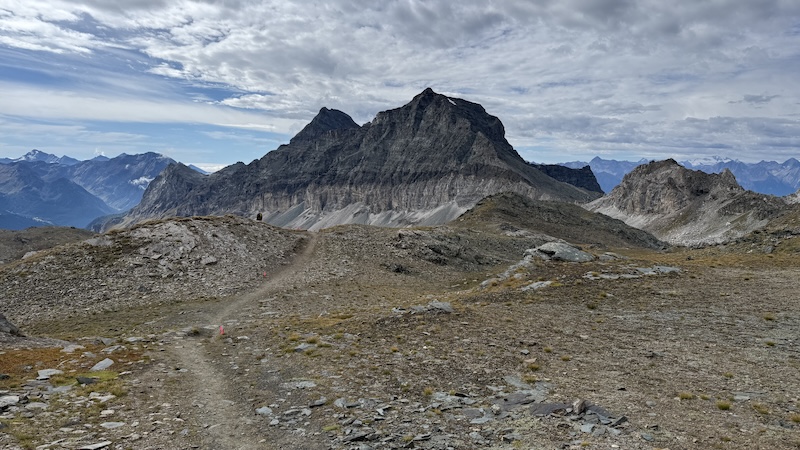
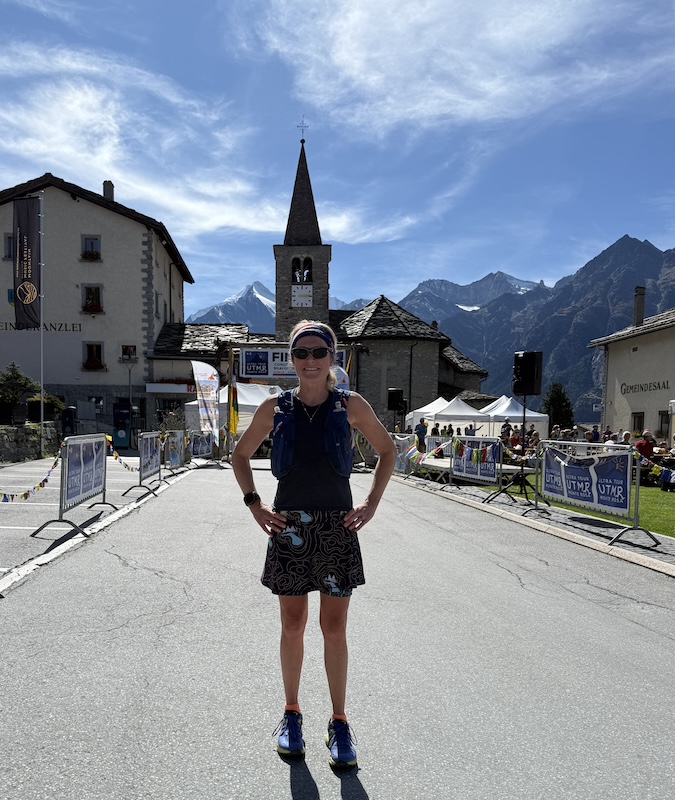
22 Try to give myself more credit
I am not a naturally self-confident person. I can have a tendency to worry about too many potential negatives, instead of reminding myself of what I have done and and successes.
Day four showed me that even with a set-back in a race that I had trained for all year, I can still have a great day. The final day of the UTMR was tough but it is easily one of the best running days in the mountains that I’ve ever had.
I need to make sure I focus on that when planning other similar adventures and believe in what I can do, rather than what could go wrong.
23 Support from home is fabulous
Friends and family were tracking me from home and sending messages of support. This meant a great deal to me, especially when things were not going so well.
24 My friends ran brilliantly
Rachel, Cath and Selina ran smartly and with great strength and determination. It was lovely to see their joy at completing the full stage race. Nat won the race for the second time (see below).
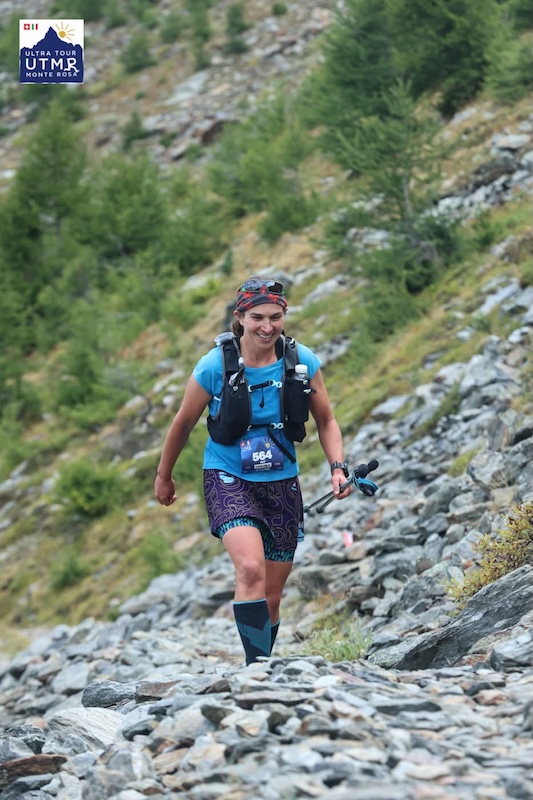
25 Some runners are very impressive indeed…
There were runners in the UTMR who were truly superb. They finished in impressive times each day and they often appeared to have hardly got out of breath or sweated. I looked at the times of Lars Ilis, of Sweden, who finished in 22:30, an hour and 45 minutes ahead of the runner up, and Britain’s Natalie Taylor, with a time of 27:19, who was 40 minutes ahead of the second female, and it seemed unbelievable that they could cover the terrain, including so much elevation, in such speedy times.
I asked Lars for his thoughts on the UTMR. Lars, 40, was first to the finish line each day of the UTMR. He said: “Every stage was a challenge of its own, trying to use my physique and accumulated knowledge to move as fast and efficiently as possible from A to B in mountains.
“My experience mainly comes from running in mountains and forests in Scandinavia although I mostly ski in various forms from November to May or June.
“Keeping your exhaustion and energy levels under control and pushing when and where it might be the best, is a game to play during every stage to get your best total time.
“I really enjoyed the last part of stage four all the way to the finish in Grächen. I felt strong and I had kept the pace solid four days in a row in a total distance and elevation gain volume that is new for me.
“UTMR is such a cool and beautiful route around the Monte Rosa massif and a dream came true to take the golden spot on such an unique event as this. For my love of moving in the mountains this was something really extra.
“I also liked meeting so many people during the race. I would recommend the UTMR stage race to anyone who is up for a mountain running challenge in beautiful surroundings and meeting likeminded people from many parts of the world. These are days that creates memories for a lifetime.”
It’s the second time that Natalie, 41, has won the UTMR. In 2022, she described it as a “great holiday”. This time, she said: “UTMR is a more than a race. It really embodies the ultra running community. This year was super special because I ran with new and old friends on the trail making the evenings more sociable and fun.”
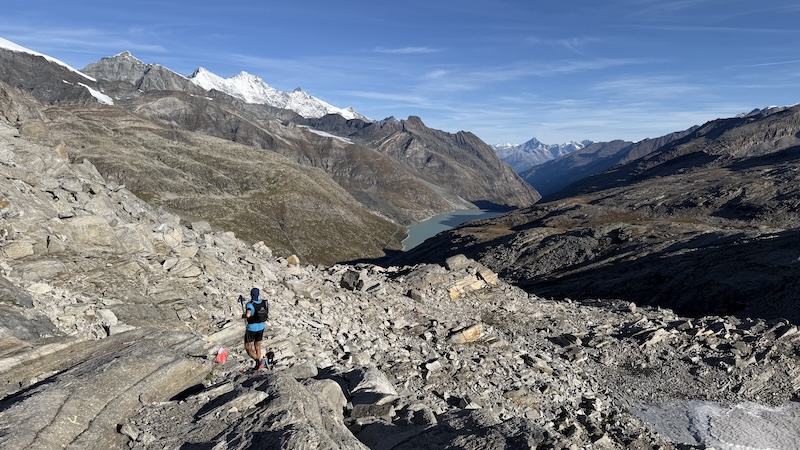
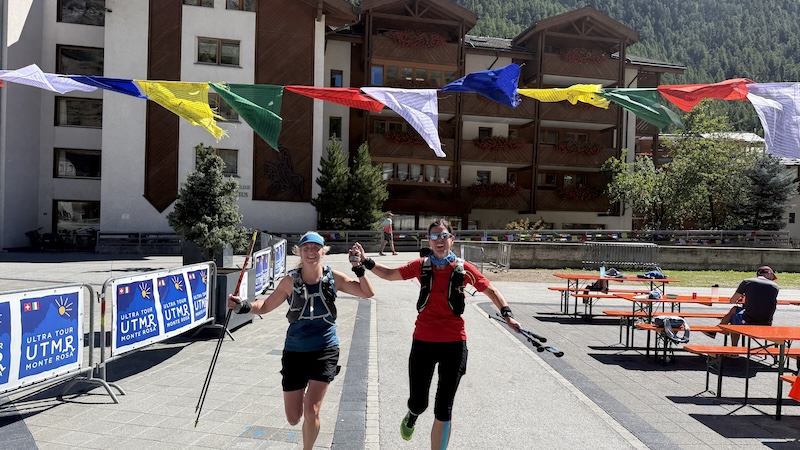
26 …But with training it’s a great event for many other runners, too
I spoke to many runners who said the UTMR was their first major stage race in the mountains and plenty of people who were “a bit older”. A few times during my training, people asked if I thought I might be too old at the age of 57 to take on my first four-day mountain stage race.
It is important to be prepared for a race such as the UTMR and that means you should train and gain mountain fitness but it’s an event that many people can complete.
I noticed in the results, the male Vet2, over 50s category, Gerard Bagnoud, from Switzerland, finished in an excellent time of 25:17, and in fifth place overall. Fabio Giapponi, also Swiss, was just 19 minutes behind him.
In the female Vet2, over 50s, category Silke Wegst of Germany finished first in 31:55. Kerstin Rosenqvist, of Sweden, was second in 33:43, and just behind was Scottish runner Allie Chong in 33:51. She was on the cusp of turning 54 and told me: “I entered the UTMR for a second time. It was a case of unfinished business because I had not been able to complete the route last year due to bad weather. I was delighted to be able to run the whole route this time.
“I was very happy with my third place in the V50 category. My aim was to place one position higher than last year, although my main aim was to simply complete the full race.
“There were many highlights, especially the mountain ascents in the mornings when the sun was rising. I also loved the peace and quiet of some parts of the route, but also the fact there are usually other runners around for parts of the day.
“For me, the technical downhills are the tricky parts of the race. Overall, it’s a tough race but I would recommend it to other people if they have experience of similar events first.”
See the full set of races on offer in next year’s Ultra Tour Monte Rosa.

